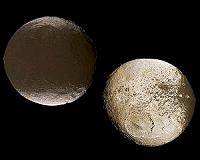 |
Barecelona, Spain (SPX) Dec 16, 2010 Researchers from the University of the Basque Country (UPV/EHU) have been monitoring a cyclone on Saturn for more than five years. This makes it the longest-lasting cyclone detected to date on any of the giant planets of the Solar System. Images from the Cassini probe were used to carry out this study. "Cyclones - where the wind turns in the same direction as the planet - do not usually last for a long time, and so we were interested to discover one that had gone on for several years on Saturn", Teresa del Rio-Gaztelurrutia, lead author of the study and a researcher at the UPV/EHU Planetary Sciences Group, tells SINC. The team started to track the cyclone in 2004, the same year that the Cassini spacecraft (NASA-ESA-Italian Space Agency) started to send back images from Saturn. The scientists have been able to confirm the persistence of this enormous cyclone, which is similar in size to the European continent, between then and 2009. The diameter of its vortex (the oval-shaped circulation of the disturbance) is in excess of 4,000 kilometres. "Our observations make this cyclone the longest-lasting one ever seen on the giant planets of the Solar System, Jupiter and Saturn", says the researcher, while admitting that "we still know very little about these kinds of structures". Even so, the team has analysed the horizontal morphology of the cyclone, the vertical structure of its clouds and its dynamics, as well as creating a model of the cyclone's internal circulation and its interaction with external winds, using mathematical simulations. The results have been published recently in the journal Icarus.
Weak winds in the interior "Another reason why it attracted our attention was its visual appearance, which is very reminiscent of the Great Dark Spot on Neptune, which - like the Great Red Spot on Jupiter - is an anticyclone", says Teresa del Rio. In anticyclones, the winds turn against the direction of the planet's rotation, and are much more stable, meaning that their vortices last much longer than those of cyclones on the giant planets. In contrast with the large and long-lasting anticyclones on Jupiter, the cyclone on Saturn has a weak circulation, with properties very similar to those in its immediate environment. The scientists are waiting impatiently for the data from 2010 so they can find out how the disturbance has evolved over the past year. The latest data available are for 2009, since NASA releases the images from the Cassini probe with a time lag of one year.
Share This Article With Planet Earth
Related Links FECYT - Spanish Foundation for Science and Technology Explore The Ring World of Saturn and her moons Jupiter and its Moons The million outer planets of a star called Sol News Flash at Mercury
 How Iapetus Got Its Ridge
How Iapetus Got Its RidgeSt. Louis MO (SPX) Dec 14, 2010 For centuries, people wondered how the leopard got its spots. The consensus is pretty solid that evolution played a major role. But it's only been five years since the arrival of high-resolution Cassini Mission images of Saturn's bizarre moon Iapetus that the international planetary community has pondered the unique walnut shape of the large (735 kilometer radius) body, considered by many ... read more |
|
| The content herein, unless otherwise known to be public domain, are Copyright 1995-2010 - SpaceDaily. AFP and UPI Wire Stories are copyright Agence France-Presse and United Press International. ESA Portal Reports are copyright European Space Agency. All NASA sourced material is public domain. Additional copyrights may apply in whole or part to other bona fide parties. Advertising does not imply endorsement,agreement or approval of any opinions, statements or information provided by SpaceDaily on any Web page published or hosted by SpaceDaily. Privacy Statement |